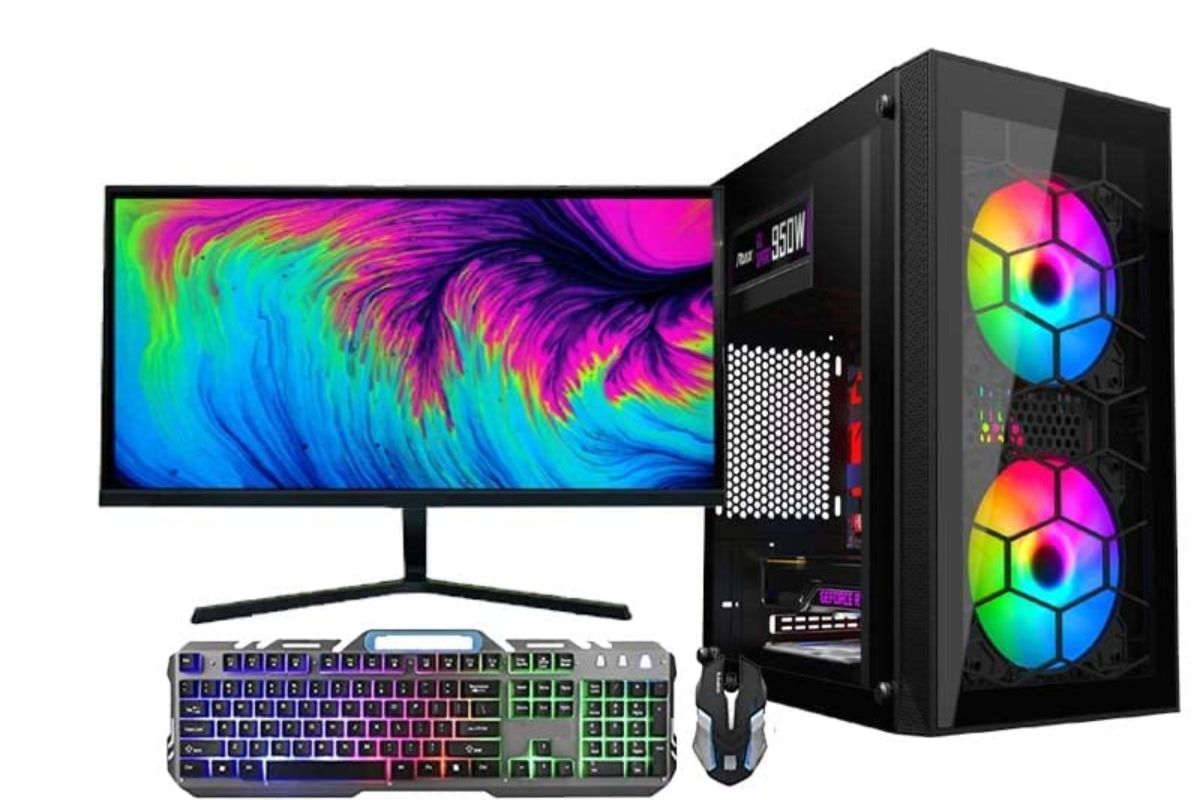Building your own gaming PC is one of the most satisfying and cost-effective ways to create a powerful machine tailored to your needs. Whether you’re a beginner or have some experience with computers, this guide will walk you through every step of the process in a simple, easy-to-understand way. You’ll learn how to select the best components, assemble them, and optimize your PC for gaming.
Why Build Your Own Gaming PC?
Building your own gaming PC comes with several advantages:
- Customization: You can choose each part based on your gaming needs. Want high frame rates and graphics quality? You can pick the best components for that.
- Cost-Effective: By building the PC yourself, you often save money compared to buying a pre-built system.
- Learning Experience: Assembling your own PC gives you a deeper understanding of how computers work.
- Upgradability: It’s easier to upgrade individual parts in a custom-built PC than in a pre-built one.
Steps to to Build a Powerful Gaming PC:
Now, let’s get into the details of how to build your own gaming PC.
Step 1: Choose Your Budget
Before you even think about components, it’s essential to set a budget. Gaming PCs can range from a few hundred to several thousand dollars. Your budget will determine which components you can afford, so here’s a rough idea:
- Budget Gaming PC (Around $500–$800): You can still run most games at decent settings but may need to adjust some graphics options.
- Mid-Range Gaming PC (Around $800–$1500): This is the sweet spot for 1080p and 1440p gaming, where you can enjoy high-quality graphics and smooth performance.
- High-End Gaming PC (Around $1500–$3000+): Perfect for 4K gaming, VR, and high frame rate performance, ideal if you want to play the latest AAA games at ultra settings.
Once you have your budget set, you can start selecting the components.
Step 2: Select the Components
A gaming PC requires several key components to function properly. Here’s a breakdown of each one and what to look for.
1. Processor (CPU)
The CPU is the brain of your gaming PC. It handles all the processing tasks, and for gaming, it needs to be fast and efficient. The two leading brands for gaming CPUs are Intel and AMD.
- Intel: Known for strong single-core performance. Great for games that rely heavily on single-threaded performance.
- AMD: Known for offering better multi-core performance at a competitive price point. AMD’s Ryzen series is highly recommended for gaming.
For mid-range gaming, a Quad-Core or Six-Core CPU should suffice. However, for high-end gaming, look for a 8-core or 12-core processor for future-proofing.
2. Graphics Card (GPU)
The GPU is arguably the most important part of any gaming PC. It handles rendering the images you see on your screen. NVIDIA and AMD are the two main players in this field, with NVIDIA offering the GeForce series and AMD offering the Radeon series.
- NVIDIA cards like the RTX 3060 or RTX 3070 are excellent choices for high-quality gaming.
- AMD cards like the RX 6600 XT or RX 6700 XT offer great performance at a slightly lower price.
Look for a GPU with a high VRAM (Video RAM), preferably 8GB or more, for smooth gameplay at higher resolutions and settings.
3. Motherboard
The motherboard is where all your components connect. It’s essential to choose a motherboard that matches your CPU socket and chipset. If you’re going with Intel, ensure you pick a motherboard with an LGA 1200 or LGA 1700 socket for the latest Intel CPUs. For AMD, an AM4 socket is most commonly used.
- ATX motherboards offer the most features and expansion slots.
- Micro-ATX and Mini-ITX are smaller but may have fewer expansion slots.
Make sure your motherboard has enough ports for future upgrades, like additional GPUs, RAM, or storage.
4. RAM (Memory)
RAM is critical for smooth performance, especially when you’re running multiple applications or playing resource-heavy games. For gaming, 16GB of RAM is typically the sweet spot. You can go with 32GB if you plan on heavy multitasking, streaming, or content creation.
When choosing RAM, look for speeds like 3200 MHz or higher, and ensure compatibility with your motherboard.
5. Storage (SSD vs. HDD)
For faster load times and smoother gaming experiences, go for an SSD (Solid State Drive) for your primary storage. NVMe SSDs are the fastest and ideal for boot drives and game installs.
You’ll also want a larger HDD (Hard Disk Drive) for extra storage space for files, videos, and less frequently played games. A good combination would be a 500GB or 1TB SSD and a 2TB or larger HDD.
6. Power Supply (PSU)
The PSU provides power to all the components. When selecting a PSU, make sure it has enough wattage to support your components, particularly the CPU and GPU. A 750W to 850W PSU should be sufficient for most gaming builds, but if you’re using a high-end GPU, you might need up to 1000W.
Look for a PSU with an 80+ Bronze, Silver, Gold, or Platinum rating for energy efficiency.
7. Case
The case is the physical enclosure that houses all your components. It’s important to select a case with good airflow and enough space for your GPU and other components. Cases come in various sizes such as ATX, Mid Tower, or Full Tower.
Make sure the case supports your motherboard size and has enough slots for storage drives and fans. Also, consider the aesthetics—many cases come with RGB lighting if you want your build to look stylish.
8. Cooling System
Gaming PCs generate a lot of heat, especially during extended gaming sessions. Proper cooling is essential to maintain optimal performance and prevent overheating.
- Air cooling: Use a good quality CPU cooler and case fans. Brands like Cooler Master and Noctua offer great air cooling solutions.
- Liquid cooling: For more efficient cooling, especially if you plan to overclock your CPU, you can opt for an AIO (All-In-One) liquid cooler.
9. Additional Accessories
You might also want to consider the following:
- Optical Drive: If you still use DVDs or Blu-rays, you’ll need an optical drive, though it’s not as essential in today’s digital age.
- Wi-Fi Card: If you want wireless internet connectivity, a Wi-Fi card or a motherboard with built-in Wi-Fi support is a good idea.
- RGB Lighting: Many gamers like to add lighting to their builds for aesthetic purposes, but it’s entirely optional.
Step 3: Assemble the Gaming PC
Once you’ve gathered all your components, it’s time to assemble your gaming PC. Follow these steps:
- Install the CPU: Gently place the CPU into the motherboard socket. Ensure it aligns properly and lock it in place.
- Install the RAM: Insert the RAM sticks into the appropriate slots on the motherboard.
- Install the CPU Cooler: If you’re using air cooling, attach the cooler to the CPU and secure it with the mounting bracket. For liquid cooling, mount the radiator in a suitable position in the case.
- Install the Motherboard: Carefully place the motherboard into the case and secure it using screws.
- Install the Storage Drives: Mount the SSD and HDD into their respective brackets or slots in the case.
- Install the GPU: Insert the GPU into the PCIe x16 slot on the motherboard and secure it with screws.
- Connect the Power Supply: Connect all necessary power cables from the PSU to the motherboard, GPU, and storage devices.
- Wire Management: Tidy up cables for better airflow using cable ties or Velcro straps.
- Add Case Fans: If necessary, install additional case fans to improve airflow.
Step 4: Power On and Install the Operating System
Once everything is assembled, connect your gaming PC to a monitor, keyboard, and mouse. Power on your system and enter the BIOS to ensure everything is functioning correctly. Then, install your preferred operating system, typically Windows 10 or Windows 11 for gaming.
After the OS is installed, update your drivers, especially the GPU drivers, to ensure maximum performance. You can download drivers directly from the NVIDIA or AMD websites.
Step 5: Enjoy Your Gaming PC!
Congratulations, your gaming PC is now ready for use! You can start installing your favorite games and enjoy smoother, faster gameplay. Don’t forget to also keep your system updated and clean from dust to ensure long-term performance.
Final Tips
- Always research compatibility before purchasing components.
- Stay patient when building—take your time to avoid mistakes.
- Keep an eye on future upgrades, as technology moves fast.
Building a gaming PC might seem intimidating at first, but with this guide, you should feel more confident in taking on the challenge. With the right components and a little patience, you’ll have a powerful gaming machine that can handle anything you throw at it. Happy gaming!

